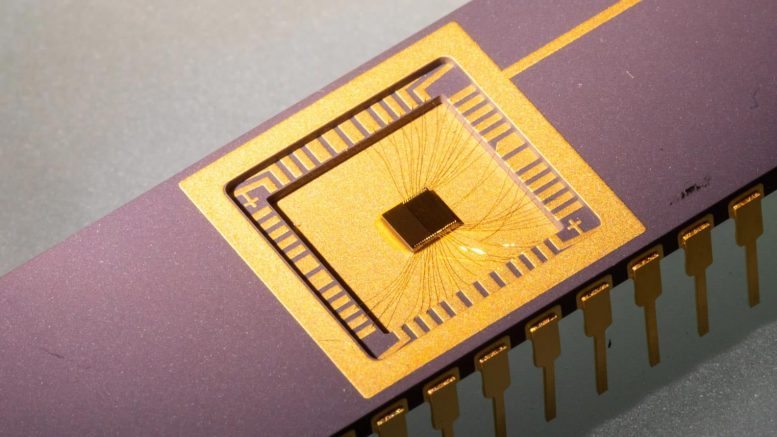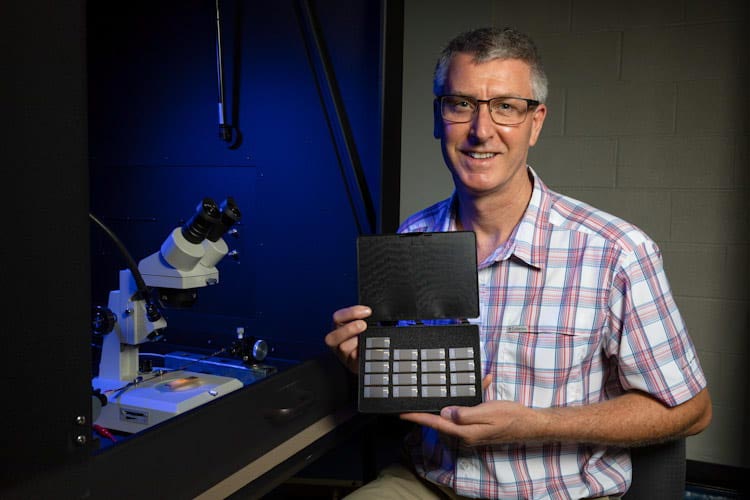
Posted on 10/02/2020 7:09:57 AM PDT by Red Badger

Researchers build circuit that harnessed the atomic motion of graphene to generate an electrical current that could lead to a chip to replace batteries.
============================================================================
A team of University of Arkansas physicists has successfully developed a circuit capable of capturing graphene’s thermal motion and converting it into an electrical current.
“An energy-harvesting circuit based on graphene could be incorporated into a chip to provide clean, limitless, low-voltage power for small devices or sensors,” said Paul Thibado, professor of physics and lead researcher in the discovery.
The findings, published in the journal Physical Review E, are proof of a theory the physicists developed at the U of A three years ago that freestanding graphene — a single layer of carbon atoms — ripples and buckles in a way that holds promise for energy harvesting.
The idea of harvesting energy from graphene is controversial because it refutes physicist Richard Feynman’s well-known assertion that the thermal motion of atoms, known as Brownian motion, cannot do work. Thibado’s team found that at room temperature the thermal motion of graphene does in fact induce an alternating current (AC) in a circuit, an achievement thought to be impossible.
===========================================================================

Graphene chip testing — A sample energy-harvesting chip under development. Credit: University of Arkansas
==============================================================================
In the 1950s, physicist Léon Brillouin published a landmark paper refuting the idea that adding a single diode, a one-way electrical gate, to a circuit is the solution to harvesting energy from Brownian motion. Knowing this, Thibado’s group built their circuit with two diodes for converting AC into a direct current (DC). With the diodes in opposition allowing the current to flow both ways, they provide separate paths through the circuit, producing a pulsing DC current that performs work on a load resistor.
Additionally, they discovered that their design increased the amount of power delivered. “We also found that the on-off, switch-like behavior of the diodes actually amplifies the power delivered, rather than reducing it, as previously thought,” said Thibado. “The rate of change in resistance provided by the diodes adds an extra factor to the power.” The team used a relatively new field of physics to prove the diodes increased the circuit’s power. “In proving this power enhancement, we drew from the emergent field of stochastic thermodynamics and extended the nearly century-old, celebrated theory of Nyquist,” said coauthor Pradeep Kumar, associate professor of physics and coauthor.
According to Kumar, the graphene and circuit share a symbiotic relationship. Though the thermal environment is performing work on the load resistor, the graphene and circuit are at the same temperature and heat does not flow between the two.
VIDEO OF PROCESS AT LINK:
Thibado’s energy-harvesting circuit uses the atomic motion of graphene to generate an electrical current that can perform work. Credit: Illustration by Ashley Acord.
=========================================================================
That’s an important distinction, said Thibado, because a temperature difference between the graphene and circuit, in a circuit producing power, would contradict the second law of thermodynamics. “This means that the second law of thermodynamics is not violated, nor is there any need to argue that ‘Maxwell’s Demon’ is separating hot and cold electrons,” Thibado said.
The team also discovered that the relatively slow motion of graphene induces current in the circuit at low frequencies, which is important from a technological perspective because electronics function more efficiently at lower frequencies.

Paul Thibado, professor of physics, holds prototype energy-harvesting chips. Credit: Russell Cothren, University of Arkansas
=============================================================================
“People may think that current flowing in a resistor causes it to heat up, but the Brownian current does not. In fact, if no current was flowing, the resistor would cool down,” Thibado explained. “What we did was reroute the current in the circuit and transform it into something useful.”
The team’s next objective is to determine if the DC current can be stored in a capacitor for later use, a goal that requires miniaturizing the circuit and patterning it on a silicon wafer, or chip. If millions of these tiny circuits could be built on a 1-millimeter by 1-millimeter chip, they could serve as a low-power battery replacement.
Reference: 2 October 2020, Physical Review E. DOI: 10.1103/PhysRevE.102.042101
The University of Arkansas holds several patents pending in the U.S. and international markets on the technology and has licensed it for commercial applications through the university’s Technology Ventures division. Researchers Surendra Singh, University Professor of physics; ; Hugh Churchill, associate professor of physics; and Jeff Dix, assistant professor of engineering, contributed to the work, which was funded by the Chancellor’s Commercialization Fund supported by the Walton Family Charitable Support Foundation.
If this is in fact converting heat into electricity, it should also have a refrigerating effect or it would violate the conservation of energy law.
Small amount, I’m sure.................
That’s my gut reaction as well.
Not to sound like a jerk—-but there are a LOT more low energy chips using electricity than there are 3000 pound cars.
Baby steps first.
If it’s Feynman against this guy, I’ll take Feynman.
Apparently Dan Rather knows but call him Kenneth if you do ask him.
Graphene is one of the most expensive materials on the planet. Takes a lot of energy to make it.
Thank you, that was my thought as well. The voltage (or power) output should vary with ambient temperature. You take power out of the graphene, it should cool slightly. Room temperature raises the temperature of the graphene again, and you can take some more power out of the chip again.
At very low temperatures, there wouldn't be much power to be had out of the graphene chip.
Feynman didn’t have the tools and materials to work with the modern physicists have..............
Flying Cars are just around the corner!
If they can crack that nut then turning water into hydrogen and oxygen without the high energy process of electrolysis would be a game changer.
Second, the graphene may not be producing any energy at all, but action as an energy capture device from slight variations in room temperature. Imagine on a large scale hooking up the coiled bimetallic element in a thermometer to a generator. As the room heats up it turns one way and as the room cools it turns the other. You would get a little bit of electricity from that.
But what about moving a 3000 lb car down the road at 60 mph,** in the dead of winter with heater going full blast up a 8% mountain grade?
From the article:
Thibado’s team found that at room temperature the thermal motion of graphene does in fact induce an alternating current (AC) in a circuit, an achievement thought to be impossible.
1.23 volts, is required, if memory serves. Not sure what kind of efficiency would be required to make it viable if micro-amperages were employed. I used to wonder about synthetic plants. Graphene might make good “leaves.”
Hope they figure out how to easily make graphene.
Unless I learn something else, the best I can see from this might be Internet-of-Things uses.
No one would say that the capacitor and inductor in a radio turning circuit are powering the radio.
“could be harnessed” or “HAS been harnessed” ?
I COULD date Kate Upton, but HAVE I?
Powering cheap miniature sensors in a network seems plausible. I am hard put though to imagine other applications.
Disclaimer: Opinions posted on Free Republic are those of the individual posters and do not necessarily represent the opinion of Free Republic or its management. All materials posted herein are protected by copyright law and the exemption for fair use of copyrighted works.